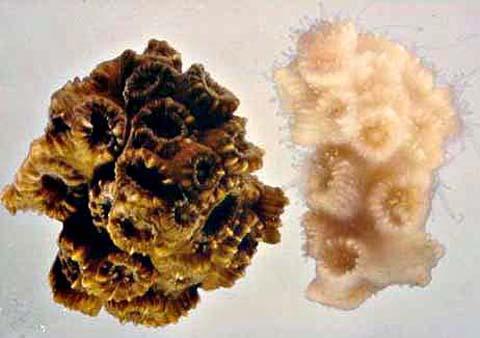- About MAA
- Membership
- MAA Publications
- Periodicals
- Blogs
- MAA Book Series
- MAA Press (an imprint of the AMS)
- MAA Notes
- MAA Reviews
- Mathematical Communication
- Information for Libraries
- Author Resources
- Advertise with MAA
- Meetings
- Competitions
- Programs
- Communities
- MAA Sections
- SIGMAA
- MAA Connect
- Students
- MAA Awards
- Awards Booklets
- Writing Awards
- Teaching Awards
- Service Awards
- Research Awards
- Lecture Awards
- Putnam Competition Individual and Team Winners
- D. E. Shaw Group AMC 8 Awards & Certificates
- Maryam Mirzakhani AMC 10 A Awards & Certificates
- Two Sigma AMC 10 B Awards & Certificates
- Jane Street AMC 12 A Awards & Certificates
- Akamai AMC 12 B Awards & Certificates
- High School Teachers
- News
You are here
Mathematical Model Reveals Why Coral Dies Under Certain Conditions
April 6, 2010
Biologists at Cornell University are using a mathematical model to help them better understand coral bleaching and disease.
Healthy coral relies on a microbiological community in its mucus layer to protect it from disease and inhibit invasion and overgrowth from pathogenic bacteria. The researchers simulated bacterial community dynamics within coral mucus layers under normal conditions and water warming states. The model revealed that warming waters turned out to be the culprits. They cause a shift on the coral's surface from beneficial bacteria to pathogens.

A comparative photo of unbleached (left) and bleached (right) coral from Wikipedia.
"There's a critical threshold where the system jumps to a pathogen-dominated state," said Laura Jones, Cornell senior research associate in ecology and evolutionary biology.
Jones said, prior to this study, understanding of coral disease and bleaching relied solely on observations with little understanding of the mechanism. Cornell colleagues Stephen Ellner and Justin Mao-Jones, and Kim Ritchie (MOTE Marine Laboratory) contributed to the study.
The team discovered that their mathematical model replicated a known pattern. Once the disease-causing microbes established themselves, they persisted even after the waters cooled down enough to favor the growth of beneficial bacteria.
Reducing poor water, which stresses coral and makes the oceans more hospitable to pathogens, could also be a factor in warding off shifts to pathogens dominating some coral surfaces, Jones added.
Source: Cornell University Press Release (March 30, 2010).
Id:
819
Start Date:
Tuesday, April 6, 2010




